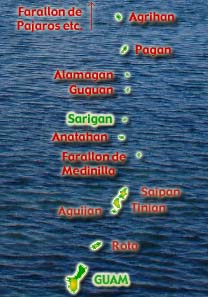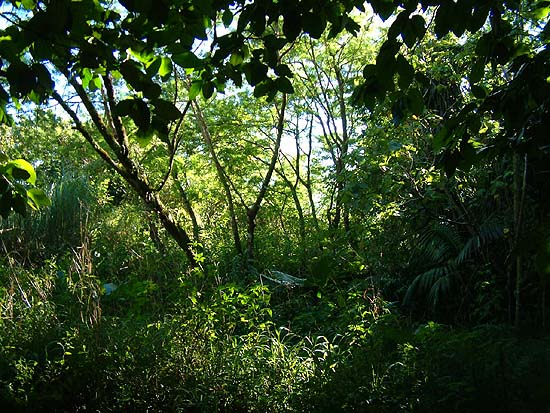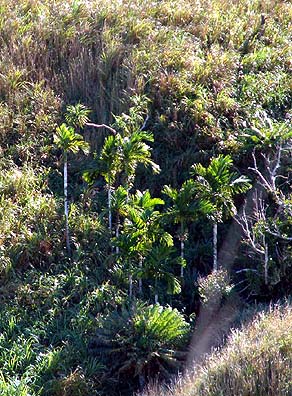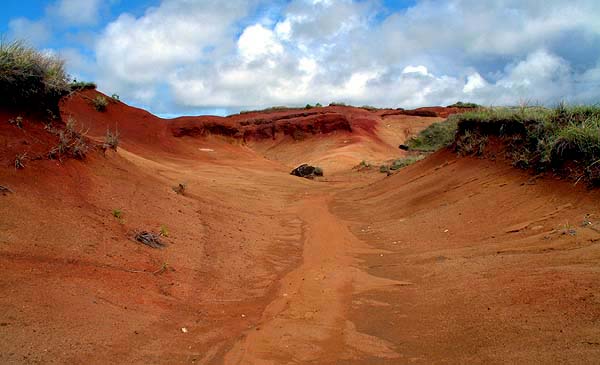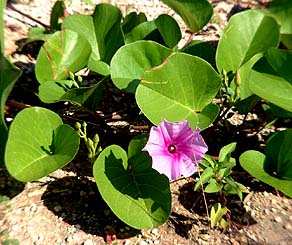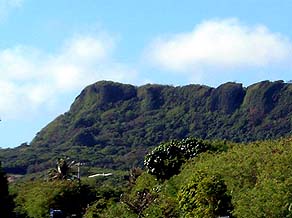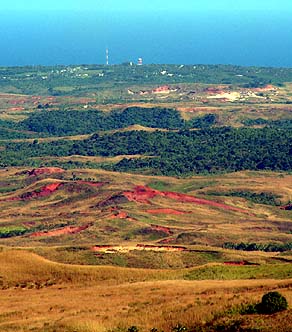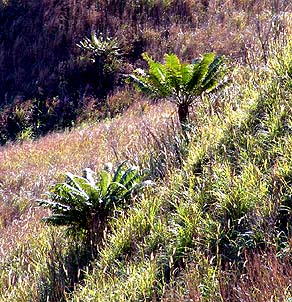 |
 |
 |
 |
||||
|
|
|
|
|
|
|
|
|
|
|
|||||||
|
|
|
|
|
|
"The forest has always been respected and protected," says Rufo. "Because from the forests, you derive medicinal plants, you also derive food, and betel nut of course, which is very important in our culture. "The forest is also a place where our taotaomo’na live. The ‘people that came before us,’—ancestors, spirits. For that reason, there has always been a reverence for certain places, and some places are more revered than others. "In Inarajan your latte sites would be the areas that are respected. And when people go to these areas, they ask permission. And I may be a modern person, an educated person, but believe me, I do believe in that. I’ve never experienced that here, but I’ve experienced that elsewhere."
|
||
|
|
||
|
"I went to Sarigan island, about 180 miles north of Saipan, and it also has a lot of latte sites. And one day I was walking around — it’s just a small island — and ‘nature called,’ and I forgot my respect. And after that, my right leg got swollen up, and I went back to Saipan to see a doctor, and they didn’t know what was wrong with me. "What did I do? I consulted some of the people that had gone with me to the island, which included some Carolinians. I talked to them, and told them ‘I got this problem, what do you think happened to me?’ And I relayed what I did, and they said, 'Well, you should have asked permission.' And I didn’t."
|
|
|
"See, the Carolinians that traveled with me, as soon as they reach land, the first thing they do is to make an offering. To make an offering, they’ll take, well, anything. If all you have is cigarettes, then offer a stick of cigarette, and then you ask permission from the ancestors and the spirits."
A Carolinian canoe resides in Hagåtña. The art of making canoes from forest products was lost on Guam after the Spanish-Chamorro wars of the late 1600s.
|
|
|
|
|
"There are a lot of Chamorro beliefs about practices concerning the environment," Anne explains. "When you enter any jungle area, you’re supposed to ask permission, ask the spirits’ permission. And then you’re not supposed to abuse the environment. In particular, you’re not supposed to over-harvest or anything like that, because if you abuse it, it won’t come back to you, but if you respect it, then the next time you go there will be some there again. "This connects to a value called inafa’maolek. The word maolek means 'good,' and inafa’maolek means 'to make things good.' The philosophy behind inafa’maolek is very broadly that what you do to others, it will happen to you, so you need to have respect and balance. The whole concept of inafa’maolek is about respecting your family, respecting elders, and respecting the environment."
|
||
|
|
||
|
"The ancient Chamorros’ belief about life was that you have your physical life and then when you die you just take a different form, you become a spirit. And the spirits of those humans we call them now taotaomo’na. Taotao just means 'people' and mo’na means 'before,' so taotaomo’na is 'people of the past.' :But the Chamorros even today have a belief that taotaomo’na live in the environment, in trees, in rocks, in the water, just anywhere in the environment. So that’s one of the reasons why you have to respect the environment because the spirits of the ancient people live there."
|
|
|
|
"There is a word gågao—'to ask'," Bill adds,"like for instance if you’re going to use the bathroom, you would have to ask. Likewise with the spirit. For me, it has a lot of goodness. The same way with fishing, and the weaving of the basket traps, these things were devised so that you catch only what was actually needed. And if you catch more than what you are supposed to eat, then you need to share that with somebody so that it doesn’t go to waste. "So this system of respect was called gågao where you ask for something, and so respect that. When you ask, it’s okay for you to use whatever it is that you’re going to use. You take whatever it is that you need and let go of the others. "Also, for instance, in harvest of things like mangos, there is this belief that in dying there is life. So take whatever it is from the mango tree that you need (and don’t try to get as much as you can for the sake of getting it) but also you need to let something go down to that land, so that it dies. And there it adds that life."
|
|
|
|
Gully erosion in the Inarajan uplands.
|
"On top of the hills we have our grassy area," Rufo explains. "That’s a savanna-type vegetation or habitat. And then we have our ravine-type vegetation along the rivers and streams. This is where the forests are. "Also there are certain portions of Inarajan, like Malojloj, towards the coast there, where you have upraised limestone, so the vegetation is distinctly different from, let’s say, the Atate area, because it’s limestone, it’s more similar to what you see in northern Guam. You have plants there that you find up in northern Guam that you do not find in the savanna or ravine ecosystems. "Finally, we have our strand vegetation which is close to the shore."
|
||
|
|
||
"There are trees on the mountains, hundreds and hundreds of trees, " Ben exclaims, "but if you are considering like the pine trees in Canada, or in Yellowstone, we don’t have that, because those places don’t have a disaster like what we have, where the wind of the typhoon is so strong. "When I go to Canada or California I can see all those really huge redwood trees, and some of them are 1000 years old. Well, unfortunately we cannot have that. Because of the location we have, it’s impossible for Guam to grow trees that will withstand 250 mph wind, typhoon erosion and all those things. Those are the problems.
|
|
|
"I guess God, the Dear Lord the Creator, put us in a spot where it’s like a machine that’s always going. The typhoons are always chopping it down. And then we need the broom and the stick, the mop to come and do its job. "I encourage the government to bring in trees that can stand 250 mph wind, and plant them all over the mountains, where it would protect the soil from eroding. The sword grass is very good because it holds down the ground from eroding, and that’s what I’m glad about, is that some of our grasses here are pretty good."
|
|
|
|
|
Sword grass, whose sharp leaves easily cut skin, predates Western arrival on Guam, we are told. We asked Jeff Barcinas and John Brown why there was so much grass and so little forest upland: "We have heavy burning during the dry season," Jeff explains. "There are many reasons for it. Sometimes it's the farmers, as they burn to clear a lot instead of coming in and plowing. Sometimes it just seems that there are a couple guys down there running a contest to see who can burn the biggest area. "But burning is also used for purposes of poaching deer. There are some deer roaming wild, wild pigs and wild animals. When you’re in a truck and you’re shining spotlights at night, what you’re looking for is the deer’s reflection off the eyes. And in tall grass, your range is very limited. In short grass, you can shine that light for a long distance."
|
|
|
|
"Efforts right now are being made at re-forestation," Jeff continues, "but with the amount of burning that is taking place, it is difficult. Inarajan Umatac and Merizo are the main areas where you see a lot of burning. And those fires get nasty, especially with the sword grass. Those are nice kindling and they pop. I know John, when he lived up there, had some close experiences with some of those fires." "Close enough I was in a little bit of a panic most times," John remarks. "And the fires usually happen on a windy day, because the dry season is the windy season. Starting January, until the first part of May, during the really dry season, the sword grass dries up. It takes about two weeks of good dry weather for the sword grass to dry up enough that it’ll burn away. And then with the tradewinds, the fire just runs through the sword grass, 20, 30 feet high."
|
|
|
|
"And sometimes people burn just to make it easier to walk," Jeff adds. "That sort of grass is awfully incompatible with hiking, but the burn areas are nice, smooth easy walking. Then after burning, the young grass comes up." Looking at the uplands of Inarajan, it is easy to see that where there are pockets of forest, they are in the stream and river valleys. The next page looks at the surface waters of Inarajan.
|
||
|
|
||
|
|
|
|
|
|

|
| Inarajan Home | Map Library | Site Map | Pacific Worlds Home |
|
|
|
|
|
|
|
|||
| Copyright 2003 Pacific Worlds & Associates • Usage Policy • Webmaster |
|||

